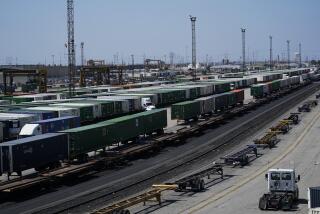FAA Plan to Muffle Jet Sound Spurs Conflict on Local Rules
- Share via
WASHINGTON — The Federal Aviation Administration has drafted new rules designed to quiet the growing clamor over noise pollution around the nation’s airports, but so far the proposed regulations have done little to reduce the volume of the debate.
Instead, the new national airport noise policy, as the package is called, has provoked new conflicts--between federal and state regulators and between the air transport industry and unhappy citizens.
BACKGROUND: Unveiled in February, the FAA plan would force airlines to spend $4.4 billion or more over the next nine years to replace their noisiest Stage II aircraft--which constitute about 55% of the fleet--with quieter Stage III planes such as DC-10s, MD-80s, 757s and 767s.
That would mean quieter planes for virtually every commercial airport in the country.
In exchange, however, the new package would provide the industry with more uniformity in regulations and protect the airlines’ investment in quieter planes by virtually prohibiting local airport authorities from imposing new noise restrictions of their own.
PROPONENTS: Proponents make the politically appealing argument that the plan offers noise relief to communities surrounding all the nation’s airports. Deputy Transportation Secretary Elaine L. Chao says it was developed “to ensure that local communities receive steady noise relief at a manageable cost. We believe this will virtually eliminate the need for each airport to develop alternative plans.”
Moreover, the FAA and its backers argue that commercial aviation, affecting as it does all parts of the country, is exactly the sort of thing that requires a nationwide policy.
“Things have been tightened and tightened in different ways at airports across the country for years now,” says Tim Neale of the Air Transport Assn., which represents the major U.S. airlines. “The airlines don’t want to see that same thing happen again.”
Julie H. Ellis, regulatory director for Federal Express Corp., which lobbied heavily for the legislation that required the FAA to develop the new noise policy, agrees. “As we move our fleet to Stage III standards through new aircraft, re-engining or retrofit, our concern was that investment became almost worthless if we could not ensure that we could fly those (Stage III) airplanes into all U.S. airports in the hours we have to fly,” she said.
Ellis points out that under the new policy, local governments are free to choose against building new airports if they want. But she cautions that in such cases, “you constrain your growth and you constrain your tax base and you constrain your jobs.”
OPPONENTS: Opponents argue that larger numbers of somewhat quieter planes could add up to a bigger noise problem--especially at night, when companies such as Federal Express want to fly--and the new plan would handcuff local officials in dealing with problems that can stir powerful feelings at the grass-roots level.
Although the proposed FAA policy would not ban new local noise controls outright, airport authorities could not impose new restrictions on the quietest aircraft without FAA approval.
Airports would have to pay for lengthy--and potentially costly--studies to support their positions. (Under the plan, local noise control rules that were adopted before last October would remain in effect.)
Airport officials worry that the complicated review process and the requirement for FAA approval could cripple efforts to build new airports in the most congested areas--particularly in states with strict environmental laws.
OUTLOOK: Some compromise appears to be in the offing, but the basic plan seems likely to be put in place.
The Transportation Department, which will publish the final rules by July 1, sees the proposed policy as a carefully balanced trade-off.
Moreover, the FAA has traditionally been sympathetic to industry concerns.
More to Read
Inside the business of entertainment
The Wide Shot brings you news, analysis and insights on everything from streaming wars to production — and what it all means for the future.
You may occasionally receive promotional content from the Los Angeles Times.










